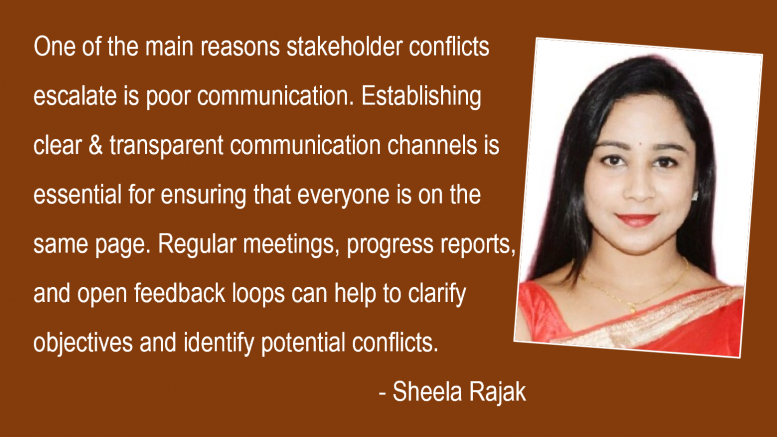In the complex world of public relations, achieving consensus among stakeholders can be a daunting challenge. Each group—whether they be internal departments, executives, clients, or external partners—has its own set of priorities, goals, and perspectives. These differing visions can create friction and lead to conflict, especially when it comes to defining the objectives of a PR campaign. Navigating these conflicting interests is a critical skill for PR professionals, as it can ultimately make or break the success of a campaign. The key question is: how do you foster collaboration amid such divergent views?
Understanding the Stakeholders
The first step to managing conflicting interests is to identify the stakeholders involved in the PR campaign. Stakeholders can be broadly categorised into two groups: internal and external.
- Internal stakeholders include employees, management, and shareholders. Their goals are often aligned with organisational growth, reputation, and profitability.
- External stakeholders consist of customers, media outlets, industry partners, regulatory bodies, and the general public. Their priorities may vary widely, ranging from brand trust to social responsibility and transparency.
The primary conflict usually arises when one group’s interests do not align with another’s. For example, internal stakeholders may focus on profitability, while external stakeholders might prioritise ethical concerns or customer satisfaction. As a PR professional, your role is to balance these interests and steer the campaign towards a unified vision that serves the overarching objectives of the organisation.
The Common Causes of Conflict
The root causes of stakeholder conflict in PR campaigns typically stem from:
- Diverging Objectives: While marketing teams might focus on revenue generation, customer service departments may be concerned with maintaining brand trust and satisfaction. Meanwhile, executive leadership may push for a short-term increase in visibility, potentially at the expense of long-term credibility.
- Different Perspectives: Some stakeholders might be more concerned with external public perception, while others focus on internal communication or crisis management. These differing perspectives can create friction when trying to define the goals of a campaign.
- Competing Priorities: Public relations campaigns often have multiple goals—brand awareness, reputation management, or crisis mitigation—which can sometimes conflict with one another. For instance, promoting aggressive sales campaigns may erode public trust if it clashes with the brand’s ethical stance.
- Resource Constraints: Limited budgets, time constraints, and human resources often force stakeholders to make tough choices about which aspects of a campaign to prioritise. This can lead to disagreements over where to allocate resources.
Strategies for Navigating Conflicting Stakeholder Interests
While stakeholder conflict is almost inevitable, it doesn’t have to derail the campaign. Here are some strategies for tackling differing stakeholder visions in PR:
- Establish Clear Communication Channels
One of the main reasons stakeholder conflicts escalate is poor communication. Establishing clear and transparent communication channels is essential for ensuring that everyone is on the same page. Regular meetings, detailed progress reports, and open feedback loops can help to clarify objectives and identify potential conflicts before they become major issues.
- Define Clear Goals and Prioritise
At the outset of any campaign, it is critical to set clear, measurable goals that all stakeholders agree upon. These goals should be prioritised according to the organisation’s overarching objectives, and every stakeholder should understand how their input contributes to these goals. By establishing a clear hierarchy of priorities, you can avoid the common pitfall of trying to please everyone, which can lead to a diluted and ineffective campaign.
- Seek Common Ground
While stakeholders may have differing interests, there is usually common ground that can be leveraged to bring them together. For example, while a marketing team may be focused on revenue, and a corporate social responsibility (CSR) team may be focused on ethics, both may agree that enhancing the brand’s overall reputation is beneficial. By identifying shared goals, you can build a collaborative foundation for the campaign.
- Facilitate Compromise
In some cases, compromise may be the only way to move forward. This may involve adjusting certain aspects of the campaign to accommodate conflicting stakeholder interests. For instance, you may balance short-term promotional efforts with long-term reputation management initiatives, ensuring that both internal and external stakeholders feel their needs are being addressed.
- Use Data to Build Consensus
Data is a powerful tool for resolving stakeholder conflicts. When disagreements arise, empirical data—whether it’s from market research, customer feedback, or media monitoring—can help to clarify which approach is most likely to achieve the campaign’s objectives. Data-driven decision-making can also make the process feel more objective and less influenced by personal or departmental biases.
- Adopt a Collaborative Mindset
Collaboration, rather than competition, should be at the heart of any PR campaign involving multiple stakeholders. Encourage open dialogue and actively listen to the concerns and suggestions of all parties involved. A collaborative approach fosters mutual respect and trust, which are essential for overcoming conflict.
- Appoint a Neutral Mediator
If conflicts between stakeholders persist, it may be helpful to appoint a neutral party—such as a PR consultant or an external facilitator—to mediate discussions. This person can provide an unbiased perspective and help guide the conversation towards a resolution that benefits the overall campaign.
Turning Conflict into Collaboration
Conflict between stakeholders doesn’t have to be a negative force. In fact, when managed effectively, it can lead to richer, better-rounded PR campaigns that address a wider array of needs and concerns. By fostering open communication, prioritising goals, and seeking compromise, PR professionals can turn potential conflicts into opportunities for collaboration.
Navigating differing stakeholder visions is a crucial part of any PR professional’s role. Success lies in the ability to align these visions toward a common goal, transforming conflict into collaboration that ultimately drives the campaign forward.
The views and opinions published here belong to the author and do not necessarily reflect the views and opinions of the publisher.



Be the first to comment on "Conflict or Collaboration? Tackling Differing Stakeholder Visions in PR"